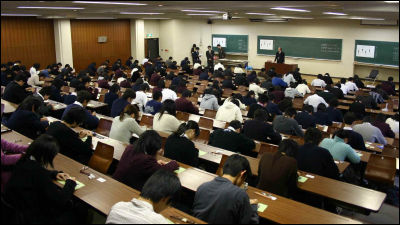Consideration is being given to splitting the National Center Test into two types, making the 'universal admission' trend at universities even more pronounced

It has become clear that consideration is being given to splitting the National Center Test for University Admissions, which has been administered since 1990, into two levels based on difficulty, replacing the Common First-Stage University Examination (Common First-Stage Examination) for applicants to national and public universities.
In addition, there have long been concerns that the declining birthrate and increasing university enrollment quotas could lead to a situation where universities are essentially 'full enrollment,' and this trend has become more pronounced compared to 20 years ago.
Click here for details.
Asahi.com (Asahi Shimbun): Two types of entrance exams based on difficulty level to be introduced in 2016 - Society
According to a report by the Asahi Shimbun, the National Center for University Entrance Examinations (NCUE) is considering splitting the National Center Test into two levels based on difficulty.
The aim is for the test to be taken by third-year high school students (currently first-year junior high school students) who have studied under the new curriculum guidelines that have been implemented in some elementary and junior high schools nationwide starting this year, starting in January 2016. At present, two types of exams are being considered: one aimed primarily at national and public universities (including some private universities), and one based on basic subjects for private universities, with each university being given the choice of which of the two to adopt.
In addition, a certain amount of the same questions will be asked in both exams, and a system will be established that will allow scores to be converted between the two. It is also expected that the government will consider introducing a test to gauge high school academic ability, separate from the National Center Test, for applicants for AO (Admissions Office) and recommendation exams, which do not require paper tests.
The reasons for dividing the National Center Test into two types include the fact that there are signs of a widening gap in academic ability among test takers, such as the graph of grade distribution in some subjects showing two peaks, one at the top and one at the bottom, and that, due to an education that emphasizes the individual, the proportion of compulsory subjects in general high school graduation credits has decreased, and the number of test takers studying common subjects has decreased, making it difficult to grasp academic ability with a single type of test.
Incidentally, there are concerns about 'universal admission' to universities due to the declining birthrate and the increase in university enrollment capacities. While the population of 18-year-olds has decreased from 2.05 million in 1992 to 1.2 million, university enrollment capacities have increased, and as a result of AO and recommendation entrance exams now accounting for more than half of private university enrollment capacities, the ratio of enrolled students to applicants has increased from the 60% range in 1990 to the 90% range, meaning that 'universal admission' is just around the corner.
In addition to reviewing the National Center Test for University Admissions, the government is also considering introducing an exam to assess the high school academic ability of applicants for AO and recommendation entrance exams.However, while there are calls for reviewing this as it could lead to a decline in academic ability, it is also true that AO and recommendation entrance exams are important systems for financially struggling universities that have managed to secure as many students as possible due to the declining birthrate, and for some universities that want to maintain a high standard deviation score by narrowing the number of general entrance exam slots.It will be interesting to see how universities desperate to survive will react to the introduction of such exams.
Related Posts:







